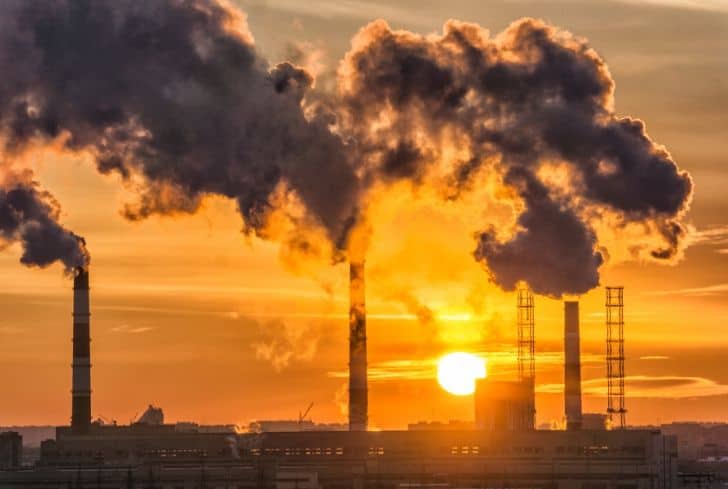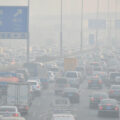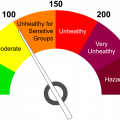Air pollution results in the release of various gases into the atmosphere, finely divided solids, or finely dispersed liquid aerosols at rates that exceed the natural capacity of the environment to dissipate and dilute or absorb them. These substances may reach concentrations in the air that cause undesirable health, economic, or aesthetic effects.
Air pollution represents a considerable threat to health worldwide. According to a Global Burden of Disease Study, exposure to outdoor fine particulate matter (PM)2·5 is the fifth leading risk factor for death worldwide. Ambient air pollution accounts for an estimated 4.2 million deaths per year due to stroke, heart disease, lung cancer, acute and chronic respiratory diseases. Around 91% of the world’s population live in places where air quality levels exceed WHO limits.
High levels of air pollution can trigger attacks (exacerbations) in people with asthma or chronic obstructive pulmonary disease (COPD). Air pollution–related lung disease increases the risk of heart and blood vessel disorders and may increase the risk of lung cancer. People living in areas with high traffic are at particular risk.
Most air pollutants cause the muscles in airways to contract, narrowing the airway (airway hyperreactivity).
Among members of the general population, especially children, long-term exposure to air pollution may increase respiratory infections and symptoms of respiratory disorders (such as cough and difficulty breathing) and decrease lung function.
Ozone, which is the major component of smog, is a strong lung irritant. Levels tend to be higher in the summer compared to other seasons and relatively higher in the late morning and early afternoon compared to other times of the day. Short-term exposures can cause breathing difficulties, chest pain, and airway hyperreactivity. Children who participate in outdoor activities on days on which ozone pollution is high are more likely to develop asthma. Long-term exposure to ozone causes a small, permanent decrease in lung function.
Combustion of fossil fuels that are high in sulfur can create acid particles that are easily deposited in the upper airway. These particles, called sulfur oxides, can cause the airways to become inflamed and constricted, causing symptoms such as breathing difficulty, and increase the risk of chronic bronchitis (inflammation of the bronchi, or large airways).
Particulate air pollution derived from fossil fuel combustion (especially diesel fuel) is a complex mixture. The particles can cause inflammation of the airways or can affect other parts of their body, such as the heart. Data from some studies suggest that particulate air pollution increases death rates from all causes, especially heart and lung disorders.
Particles affect the lung differently depending on what substances they are made from. Particles of the same material also may have different effects depending on their size and shape. The nanotechnology industry creates extremely small particles of different substances, such as carbon, for various uses. Nanoparticles and ultrafine particles are less than 100 nanometers in size. For comparison, a human hair is about 100,000 nanometers in diameter, so it would take 1000 nanoparticles to equal the thickness of one hair. Testing in animals as well as laboratory tests shows that high concentrations of nanoparticles or ultrafine particles can be dangerous. Some workers accidentally exposed to very large amounts have developed fluid around the lungs or damage to the small lung airways. But doctors do not know for certain the effects on workers in the nanotechnology industry of the amounts and types of nanoparticles that they are exposed to. Studies are being done to evaluate the risks and to ensure that workers are protected.
The levels of pollutants in the air vary based on location and environmental conditions. For example, ozone tends to remain in the air on warm, humid days, particularly in the afternoon and early evening. Carbon monoxide tends to be high during periods when there are many commuters driving to or from work. The Air Quality Index is used to communicate how polluted the air is at a given point in time. People, especially those with heart or lung disorders, can use the Air Quality Index to guide their choice of outdoor activities on days when pollution levels are high.
How To Protect Yourself From Air Pollution Related Diseases
The American Lung Association encourages everyone to get involved in the fight for cleaner, healthier air. Here are some simple, effective tips for protecting you and your family from the dangers of air pollution:
- Check daily air pollution forecasts in your area. The color-coded forecasts can let you know when the air is unhealthy in your community. Sources include local radio and TV weather reports, newspapers and online at gov.
- Avoid exercising outdoors when pollution levels are high. When the air is bad, walk indoors in a shopping mall or gym or use an exercise machine. Limit the amount of time your child spends playing outdoors if the air quality is unhealthy.
- Always avoid exercising near high-traffic areas. Even when air quality forecasts are green, the vehicles on busy highways can create high pollution levels up to one-third a mile away.
- Use less energy in your home. Generating electricity and other sources of energy creates air pollution. By reducing energy use, you can help improve air quality, curb greenhouse gas emissions, encourage energy independence and save money! Check out the U.S. Environmental Protection Agency’s easy tips for conserving energy at home.
- Encourage your child’s school to reduce exposure to school bus emissions. To keep exhaust levels down, schools should not allow school buses to idle outside of their buildings. Many school systems are using the U.S. EPA’s Clean School Bus Campaign to clean up these dirty emissions.
- Walk, bike or carpool. Combine trips. Use buses, subways, light rail systems, commuter trains or other alternatives to driving your car.
- Don’t burn wood or trash. Burning firewoodand trash are among the major sources of particle pollution (soot) in many parts of the country.
- Use hand-powered or electric lawn care equipment rather than gasoline-powered. Old two-stroke engines like lawnmowers and leaf or snow blowers often have no pollution control devices. They can pollute the air even more than cars, though engines sold since 2011 are cleaner.
- Don’t allow anyone to smoke indoors and support measures to make all public places tobacco-free.
- Get involved. Start by checking out our Healthy Air Campaign which has more information about what you can do.
Bottom line: Help yourself and everyone else breathe easier. Support national, state and local efforts to clean up sources of pollution. Your life and the life of someone you love may depend on it. Read: Which Type Of Pollution Includes CFCs And Smog?






